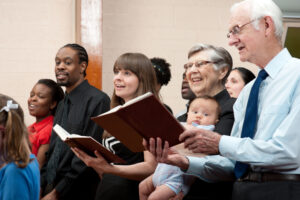The COVID-19 pandemic has had a once-in-a-generation impact on many of American society’s most trusted institutions. Churches have been particularly hard hit. And that’s leaving some of the next generation of pastors and leaders wondering what to do as they enter a struggling ministry.
COVID Delivered a Terrible Blow to Churches That Were Already Struggling
American Christian churches were already facing some tough demographic and cultural issues before the pandemic. According to Gallup polling, which has been tracking organized religion since the 1930s, fewer than half of Americans said they belonged to a house of worship of any faith in 2020.
Even worse, while attracting younger generations has been a longstanding problem, polls by the evangelical polling firm Barna, found that church attendance had been declining even among older Americans since 2012, hitting a new low of 37 percent just before the pandemic.
Explore a Christian Ministry Degree – Request More Info Today!
The fact that most faithful Christians were in the older age groups hardest hit by COVID also creates a challenge going forward. Many of the individuals who were most involved with the church, who gave with the greatest generosity, and who volunteered the longest, are now departed.
Those who remain are not just tired, but also cautious of any return to places they may be exposed to the still-circulating virus.
The End of the Pandemic Hasn’t Exactly Meant a Return to Normal
According to a survey by the Lutheran Church-Missouri Synod in May of 2021, more than 90 percent of churches had to shut their doors for some period during the pandemic. While nearly all of them shifted to online services for that period, the after-effects have been dramatic.
As the pandemic has started to wind down and restrictions have been lifted, churches have struggled to reach pre-pandemic numbers. Once-thriving youth groups and ministries have had trouble getting back into gear again. In-person events have a fraction of the number of attendees as before.
Even for churches that still have strong attendance, the rhythms are broken. Streaming services may have brought the same flexibility many people experienced working and going to school remotely during the pandemic, but parishioners worshipping at different places and at different times has led to a sense of disconnect in routine and fellowship.
Although attending church should never be just a habit, the fact is that once people have lost that reflexive Sunday excursion, it is hard to get them back again.
The pandemic hit pastors and church volunteers hard. As the front-line support for congregations in need of physical, moral, and spiritual succor, clergy were face-to-face with people experiencing suffering and loss for more than two years. Considering that church demographics also overlap with the population most vulnerable to COVID, the toll they faced has been massive.
That makes it imperative that new Christian leaders step up. With fresh ideas, your church can come back to become stronger than ever. But it will be a new normal and it will take new energy and an open mind to achieve it.
These 7 ideas can help revitalize your post-pandemic church congregation.
1. Remove Politics from Places of Worship
 Just as civil society has been split by perspectives on COVID controls, so have church congregations. Controversies about vaccines, masking, and risk have divided churches.
Just as civil society has been split by perspectives on COVID controls, so have church congregations. Controversies about vaccines, masking, and risk have divided churches.
But the brotherhood of Christianity was always intended to be larger and provide stronger bonds than relationships centered on temporal politics. Christian leaders moving forward need to heal the divides within their congregations. One way to do that is to re-emphasize the absence of politics and a focus on fellowship.
A Christ-centered church has no room for hatred or rejection. As God accepts all who accept him, Christians must also learn to accept one another with grace and kindness.
2. Return to Comfort and Solace as a Primary Offering of Pastorship
 COVID has impacted almost everyone at some level. It’s driven big wedges in society even among people who weren’t directly impacted by illness or loss. It has disrupted our culture and norms in ways that aren’t even fully understood yet.
COVID has impacted almost everyone at some level. It’s driven big wedges in society even among people who weren’t directly impacted by illness or loss. It has disrupted our culture and norms in ways that aren’t even fully understood yet.
Yet some people have been drawn back to their faith by those same challenges. And that’s one answer to falling attendance and diminishing resources: a return to church as a refuge in time of crisis.
So Christian leaders should make the kind of comfort and guidance through trauma that only God can offer a primary mission during the next few years. Whether society realizes it right now or not, what they have suffered through is exactly what God’s love can treat. Pastors should focus their ministry on reaching out to those who are hurting and delivering the kind of stability and solace they require.
3. Real World Charitable Works Will Always Draw Support
 One thing that has drawn humans together for centuries is assisting one another in times of crisis. While it can be tough to get people to sit in pews for regular services in the midst of a pandemic, one thing that most Christians have not shied away from is helping others.
One thing that has drawn humans together for centuries is assisting one another in times of crisis. While it can be tough to get people to sit in pews for regular services in the midst of a pandemic, one thing that most Christians have not shied away from is helping others.
So Christian leaders who want to build up their congregations again might do well to focus on the practical over the spiritual for a time. There are many families and individuals who are still in dire straits from long COVID, job loss, or the loss of a loved one. They need assistance, and drumming up volunteers to offer it is one way to keep parishioners connected to the church.
4. Embracing Digital Worship Offers Multiple Benefits to Rebuilding Churches
 In a way, the abrupt transition to streaming service and online pastoring forced by COVID might have been a blessing in disguise. For years, church leaders have lamented the loss of younger generations to the alure of devices and social media. Now the church is equipped to meet them on their own terms.
In a way, the abrupt transition to streaming service and online pastoring forced by COVID might have been a blessing in disguise. For years, church leaders have lamented the loss of younger generations to the alure of devices and social media. Now the church is equipped to meet them on their own terms.
Christian leaders of the next generation can lean in to the new technical and flexible capabilities that have come with preaching from a high-tech pulpit during the pandemic, however. These are exactly the same kinds of tools and techniques they can use to connect to a previously unreachable group.
5. Rearranging Ideas of What a Successful Parish Looks Like
 All this talk of statistics and declining numbers may also just be a distraction for future Christian leaders, however. The Lord does not measure your worthiness in life by Instagram likes or YouTube views. Simple exposure to the ideas of Christianity has never been a good metric for success. Retail soul saving looks impressive, but the real differences in Christian lives and living come through deep relationships.
All this talk of statistics and declining numbers may also just be a distraction for future Christian leaders, however. The Lord does not measure your worthiness in life by Instagram likes or YouTube views. Simple exposure to the ideas of Christianity has never been a good metric for success. Retail soul saving looks impressive, but the real differences in Christian lives and living come through deep relationships.
So a focus on helping people connect with God and improve their spiritual lives may be more appropriate in the post-COVID church. Engage with the parishioners you have. Forge real connections. Although this is a slower way to build church growth than going viral, it’s likely to be more lasting. Engaged and excited parishioners bring friends and evangelize better.
6. A Return to the Community in Worship and Prayer
 The physical church building can seem like an empty place after COVID… long rows of empty pews, a handful of parishioners scattered widely around the nave, some faces hidden by masks. At times it just doesn’t feel like the appealing, warm, welcoming place it was before.
The physical church building can seem like an empty place after COVID… long rows of empty pews, a handful of parishioners scattered widely around the nave, some faces hidden by masks. At times it just doesn’t feel like the appealing, warm, welcoming place it was before.
Building a church was never supposed to be about filling a building with people.
Christian leaders might do better now to focus on getting out into homes and into the community for most of their pastoral tasks.
All the evidence is that people are more comfortable worshiping in those environments today. In fact, the environment itself might be the best venue. A poll by Ipsos in 2022 found that 45 percent of Americans identified being outdoors as the most spiritually fulfilling activity for them.
Making your church where the people are is the oldest way of building a Christian church and it may now be the best way again.
7. Recognize That Rebooting Each Church Will Be Unique
 One of the most important things that future pastors must do is to realize that each church is unique. Every path to recovery will be different based on the strengths and experiences of every parish.
One of the most important things that future pastors must do is to realize that each church is unique. Every path to recovery will be different based on the strengths and experiences of every parish.
While most churches are facing a challenge in getting people back to traditional worship, others have found themselves swamped. While some churches have developed strong streaming capabilities in response to COVID, others never developed those strengths.
There’s no single playbook for rebuilding your church after a major pandemic.
For some congregations it will be relatively easy. They may return to a pattern of worship very similar to what they had before.
For others, it will be an enormous struggle. The church that results might not look much like what came before
Most importantly, though, Christian leaders will have to understand that the methods and approaches used in those situations and all the possibilities between will be different. Flexibility, acceptance, and a great deal of prayer and guidance from above will be required to find the right resolution to the challenges of a post-COVID church.










